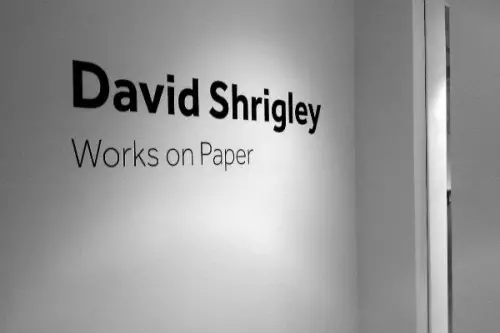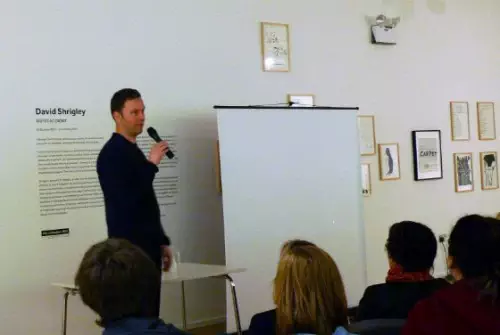Richard Claxton (@MaraidDesign) goes to hear David Shrigley at Bradford 1 Gallery and recommends some upcoming artist’s talks in Bradford …
I like to talk. I like to listen to people talk. I will travel to hear someone talk. I’ve even paid for the privilege of going to see someone talk, and I don’t think I’m alone. With the rise in popularity of the TED talks, Do lectures, and locally Bettakultcha events, hearing others express their wisdom is becoming more and more fashionable and is seen as a legitimate way to spend your spare time.
Recently I had the chance to go and see a talk by someone whose work I’ve admired for almost a decade and luckily I didn’t even have to travel far to see him. The speaker in question is the contemporary artist David Shrigley and he was appearing at Bradford 1 Gallery, to support his current exhibition ‘David Shrigley: Drawings’ that runs until Jan 2013.
David is known for cryptic drawings, regularly containing text that tries to add context and humour to the piece. He is a fine artist who appears to operate outside of the regular art world, but is represented by a major London gallery and sells work at a high price to international collectors, as well as being loved by those who don’t regularly visit galleries. Even though he has become famous because of his success there is a sense of mystique about him it feels like a definite coup to have him speaking at Bradford. To make it even better, because Bradford 1 Gallery is run by the Council, with their inclusive attitude towards the arts, the talk itself is totally free.
David has declared himself to be a naturally shy person and as he entered the gallery I felt myself getting nervous for him, but I was pleasantly surprised at how relaxed and amusing he was. He has a wonderful ability to digress and journey off at tangents and at one point spent five minutes talking about this ‘lack of microphone craft’ which involved him doing an impression of a human beat boxer. With his quirky chilled chatting style he easily relaxes the audience and entertains as he takes you through his artistic journey from trying to sell books of his drawings round Glasgow pubs to having a work called ‘Crushed Ladder’, bought by a New York collector. ‘So how did you make the piece ‘Crushed Ladder’’ he mimicked the collector asking. ‘I got a digger and crushed it’ he simply replied.
There were several times during the talk that I felt David revealed more then he would do in a formal interview about his work or his relationship with the art world and this one of the best aspects about an artist’s talks. Their candid nature and the direct connection which you as an audience member have to the artist means you find out so much than you could through any other means. It is somewhat of a worry in these times of social media and digital technology that in the near future maybe these talks won’t be so revealing because of the risk of out of context comments appearing on the internet.
When writing this post I realised that this very idea was now a problem for me and I questioned how much I reveal of what David actually said. I believe the important thing is that the event was entertaining and interesting and I feel I gained my own personal insight in David Shrigley’s work. I would encourage people to go to see other artist talks because they offer so much.
Other upcoming talks in Bradford include:
The sculptor Sophie Ryder – 16 Dec 2012 at Cartwright Hall, Bradford
The painter Ken Currie – 2 Feb 2013 at Bradford 1 Gallery
Rita Marcalo from Instant Dissidence – 19th Nov 2012 at Theatre in the Mill
Impressions Director Anne McNeill – 8 Dec 2012 at Impressions Gallery


Review by Stephen C. Baer for Rating: This is a clearly wittren short book with good news about photovoltaics by someone familiar with economics and business. Although its title is Solar Revolution, there are many aspects of solar energy in which he shows little interest and this makes the prospects for his revolution depressing. Here are the basics of the solar revolution as he sees it.The revolution’s goal is to overthrow the use of fossil fuels and nuclear power, but all without returning to any of the traditional uses of solar energy that supported mankind through history. We abandoned Mother Nature’s solar teat to suckle on giant bottles of fossil fuels. Now the bottles are going dry and we want to return to solar, but it’s got to come in bottles, be electric, be synthetic. Bradford’s concern is the preservation and continued growth of our use of electricity. When you stop to consider that electricity is a means to an end and not an end in itself as, for example, water or food this is a puzzle. Our appetites expressed through the market place are too slack for Bradford, the revolutionary. Although he claims to wish an end to subsidies, it is hard to believe him. He greatly admires Japan and Germany for their fanatical government-directed drive for photovoltaics. On September 1, 2006 Sharp electronics, a company singled out for special praise by Bradford, ran full page color picture ads in the Wall Street Journal and New York Times. They boasted that their Kameyama plant features the world’s largest solar energy system .A glance at their building shows they use no skylights. They cover every inch of roof with PV panels. The walls have few if any windows. The building looks like a giant sealed-off, above ground termite nest.The Japanese and Bradford are confused. Skylights and windows are much better at providing light than PV panels wired to light bulbs indoors. Bradford drives on saying (page 175) that R D funding by industrialized countries’ governments for renewable energy is crucial for market growth because it helps resolve a commonly observed market failure in economics that is, that businesses collectively underinvest in R D and basic science compared to what a socially optimal level would be. How does he know? Who is to decide what is socially optimal? If you look at the fate of daylight, foot travel, bicycles, clotheslines and other traditional solar powered ways, you see that we are giving up genuine, tested effective uses of the sun at the same time as we are urged to adopt synthetic hi-tech solar energy.Bradford gives only lip service to passive solar, about 1 page out of 200. . On page 187 he writes the ominous sentence, solar power will be increasingly big business because it will be increasingly good business . Yet traditional and passive uses of solar energy are the most cost effectiveAs this reader has come to expect from the MIT Press, there are a number of typos and confused mistakes such as on page 200, 1 kWh equals 3.4 Btu and on page 187, in 2003 some 10% of new electric generation capacity installed worldwide was non-hydro renewable . I found the sun, but no clouds in Bradford’s book. PV panels can supply megawatts of power one minute and when clouds arrive, almost nothing a few minutes later. How do utilities fill in? He glosses over this.Bradford’s study is part of a spell we have fallen under where we confuse consumption of electricity with success.Steve BaerZomeworks CorporationAlbuquerque, New Mexico USA